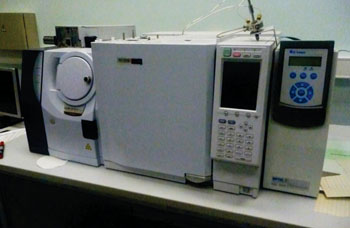Breath Analysis Aims To Reduce Unnecessary Antibiotic Prescriptions
By LabMedica International staff writers
Posted on 23 Jun 2016
A number of multiresistant pathogens including Acinetobacter baumannii place a heavy burden on ventilator-associated pneumonia (VAP) patients in intensive care units (ICU), and it is critically important to differentiate between bacterial infection and colonization to avoid prescribing unnecessary antibiotics.Posted on 23 Jun 2016
Quantitative culture of lower respiratory tract (LRT) specimens, however, requires invasive procedures, however nowadays, volatile organic compounds (VOCs) have been studied in vitro and in vivo to identify pathogen-derived biomarkers. An efficient, fast, accurate, painless and affordable test has been developed that will assist doctors in prescribing antibiotics only when the treatment is absolutely necessary.

Image: The QP2010 Plus gas chromatography-mass spectrometry analyzer (Photo courtesy of Shimadzu).
Scientists at Zhejiang University (Hangzhou, China) enrolled 20 patients with A. baumannii VAP (infection group), 20 ventilated patients with LRT A. baumannii colonization (colonization group) and 20 ventilated patients with neurological disorders, but without pneumonia or A. baumannii colonization (control group). A clinical isolate of A. baumannii strains was used for the in vitro culture experiment.
For breath sample collection and gas chromatography-mass spectrometry (GC-MS) analysis the team used a GC-MS, the QP2010 Plus (Shimadzu, Kyoto, Japan). The detected compounds corresponding to the peaks were identified by spectra matching with the above software and Mass Spectral Library (NIST 05). The retention time and mass spectrum similarities were used to identify the compounds of interest.
Certain compounds, including siloxanes, phthalate and adipate plasticizers, e.g. bis(2-ethylhexyl) phthalate and its degradation product 2-ethylhexanol, were also excluded initially. After this step, the 349 VOCs detected primarily in the in vitro studies were reduced to 21 VOCs, and the 245 VOCs detected in the in vivo study reduced to 19 VOCs. Actually, the selected compounds were present at least 90% of all samples in at least one of the groups.
Breath profiles could be visually differentiated between A. baumannii cultivation in vitro and culture medium, and among in vivo groups. In the in vitro experiment, nine compounds of interest (2,5-dimethyl-pyrazine, 1-undecene, isopentyl 3-methylbutanoate, decanal, 1,3-naphthalenediol, longifolene, tetradecane, iminodibenzyl and 3-methyl-indene) in the headspace were found to be possible A. baumannii derivations. While there were eight target VOCs (1-undecene, nonanal, decanal, 2,6,10-trimethyl-dodecane, 5-methyl-5-propyl-nonane, longifolene, tetradecane and 2-butyl-1-octanol) exhibiting characteristics of A. baumannii VAP derivations.
The authors concluded that the study mainly provides a proof of concept that the direct detection of exhaled A. baumannii-derived VOCs might be adopted for an early alert of the LRT bacterial presence in ventilated ICU patients and even different parasitic states (i.e. infection and colonization) of A. baumannii. The study was published on June 7, 2016, in the Journal of Breath Research.
Related Links:
Zhejiang University
Shimadzu













